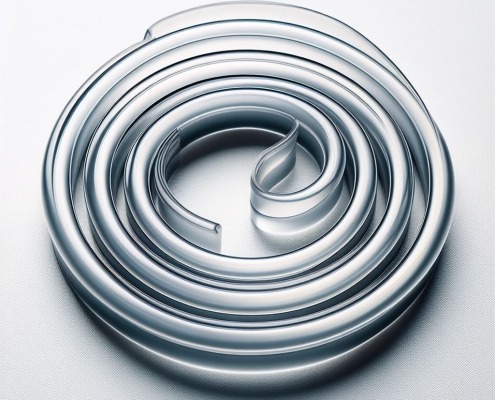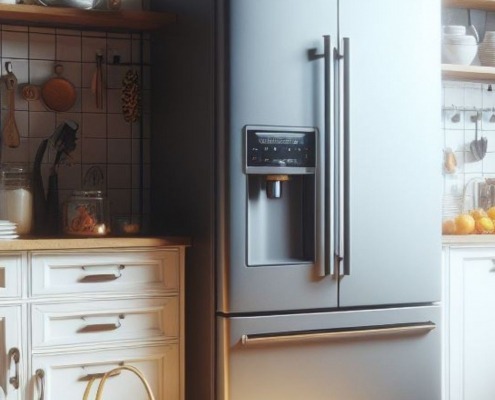Ice Maker Makes Too Much Ice: Top 3 Reason and Fixes (With Video!)
APP Expert / Monday July 4, 2022
Is your ice maker turning your freezer into a glacier, cranking out more ice than you can handle? Don’t sweat it—you’re not alone, and we’ve got the perfect solution. Dive into our how-to video just below, where we guide you step-by-step on troubleshooting this frosty problem, and get your ice maker back under control in no time!
Once you have identified the part needed for your refrigerator, search below using your specific fridge model number to identify the exact part needed:
We know it’s hot right now, but do you find your refrigerator’s ice maker working overtime? Are you inundated with ice? You don’t need to live with being buried under a mess of cold cubes. If your ice maker is making too much ice, the problem is almost certainly localized in the ice maker assembly itself, and finding and fixing the problem can take as little as thirty minutes!
In this guide, we’re showing you how to troubleshoot an ice maker that’s producing too much ice. Before we get to it, why not check out our video guide? Not only will it walk you through what to test, it also includes some additional tips not included in this guide!
How Does An Ice Maker Work?
Refrigerator ice makers come in a variety of styles, the two most popular being the half-moon and flex tray styles. These styles refer to what sort of ice is being produced. Half-moon ice makers produce rectangular cubes with rounded edges – half-moon shapes, basically. Flex tray ice makers utilize a traditional flexible ice tray, and can come in a number of different shapes. Most typically, they produce cube ice.
For our purposes in this guide, the style of your ice maker won’t matter, because ice makers all consist of the same types of parts and function in roughly the same way. You can expect to find the following parts on your ice maker:
- The ice bin, which on some models may include an auger for dispensing ice from a front dispenser
- A control, found at the head of the ice maker itself. This part houses the components that manage the ice making cycles.
- An actuating arm, called the shut-off arm, which tells the ice maker how much ice is in the bin.
- A tray, where the ice is made, and connected blades that eject the ice from the tray.
- A thermostat that measures the temperature of the tray
- A heating coil, which loosens finished ice cubes from the tray
- A spout on the back wall of the refrigerator, which pours water from the water line into the ice maker.
An ice making cycle starts when the water inlet valve is signaled to allow water into the ice maker. Water is pumped through your refrigerator’s water filter, then into the ice maker’s ice molds via a spout at the back of the compartment. From there, it’s time to wait. The thermostat measures the temperature of the ice tray, and when it reaches a certain temperature – between 5 and 9 degrees Fahrenheit – the cubes are frozen. Now, a signal is sent to the ice maker’s control and the heating coil is activated. The tray is warmed just enough to loosen the ice inside so that it will slip out when ejected from the bin.
Ice is then dropped into the ice bin. At this point, the cycle repeats, and as the bin fills, it gradually raises the actuating arm. When the arm is raised high enough, it will signal to the ice maker that the bin is full, and the ice maker will stop producing ice.
Ready to take a look at what could be causing your ice maker to make too much ice? Let’s go!
Troubleshooting An Ice Maker That Dispenses Too Much Ice
In this guide, we’re troubleshooting in-refrigerator ice makers, rather than stand alone models. Our tutorial covers ice makers found in all major refrigerator brands, including GE, Frigidaire, Whirlpool, Maytag, LG, Kenmore, Samsung, KitchenAid, and more. Because ice maker and dispenser assemblies all work in roughly the same way, this guide should help you out no matter your fridge’s brand or model.
Before You Begin…
For safety, you should disconnect the refrigerator from power either at the wall outlet or circuit breaker. Never perform maintenance on an appliance that is still receiving power, especially if you’re doing work on electrical components. For this job, you’ll also want to shut off the water supply, which you should be able to do via a valve beneath your sink.
While it should only take you a few minutes to inspect the various parts of the ice maker, you’re still going to be working with the freezer or refrigerator door open and the power off. If you’ve got any food that might melt or spoil or medication that must be maintained at a low temperature, you should move that to a temperature controlled location, like a cooler packed with ice.
Inspecting The Ice Maker
First things first, remove the ice bin. This will give you access to your ice maker assembly. Most likely, you’ll find this in the freezer compartment of your refrigerator, but some fridge models store the ice maker in the fresh food compartment.
1. The Ice Bin
It’s already in hand, so let’s start by checking that first. Is it broken in any way? If the ice bucket is broken in such a way that it sags, sits low, or disrupts the ice maker’s arm, it could be causing your issues, necessitating replacement.
In some rare instances, particularly if you’ve purchased your refrigerator second hand, the refrigerator may have the wrong ice bucket entirely. If it’s not an OEM ice bucket, there’s a chance it is too deep or isn’t fitting in your ice maker housing right. As a result, ice isn’t sitting in the bucket the right way, and the shut-off arm is taking too long to be actuated.
You may also want to check the housing itself, to make sure that the rails the ice bucket sits on are not damaged. If any part is damaged, or if you have the wrong ice bucket, the component will need to be replaced. Luckily, you can usually buy a replacement ice bucket without having to purchase an entire ice maker assembly. If the housing itself is damaged, that may be a larger purchase.
2. The Shut-off Arm
Shut-off arms can generally be found on the side or bottom of the ice maker. As the ice bin fills with ice, the ice moves the arm either up or over. When the arm is pushed all the way up or in, it signals to the ice maker’s control that the bin is full and the ice making cycle needs to stop.
Your ice maker will have a shut-off arm, so if you can’t find one, it may have fallen out and will need to be replaced. To test this part, check by hand to make sure that the arm is mounted properly and that it is not stuck in the empty position. It should rise and fall or go in and out easily. If it’s sticking or if it’s metal and showing signs of corrosion, it is likely the cause of your problems and will need to be replaced.
3. The Control Head
A couple of different things can go wrong with the control head. Most notably, the point that the shut-off arm connects to the control head can break. You may have already noticed that damage while inspecting the shut off arm. If you do not see any other damage to your ice maker and it is still producing too much ice, even when the shut-off arm is locked in the full position, it’s likely that one of the switches inside the control head has failed.
Depending on the model of your refrigerator and how compatible ice makers are sold, you may be able to purchase a replacement control head alone, but more often if the control head has failed, the entire ice maker assembly will need to be replaced.
Finding The Right Replacement Part
Now that you’ve done some troubleshooting, you likely know there’s some component that needs to be replaced. Depending on your refrigerator’s brand and model, you may be able to buy each individual part of your ice maker’s assembly, or you may have to buy an entirely new ice maker assembly.
To figure out exactly what you’ll need, you’ll want to search for parts via your appliance’s model number. All refrigerators have that information printed on a sticker somewhere on the body. Check the following locations to track it down:
- On the exterior door or sides of the appliance
- Inside the door or on the door frame
- On the interior ceiling of the freezer or refrigerator compartment
- On the inside wall of either compartment
- On the fridge floor, beneath the crisper drawers
- Behind the kickplate at the bottom of the appliance
Once you have that model number, you can track down individual parts and entire new assemblies with ease. Search on AppliancePartsPros.com and search by that model number. You’ll get a full list of compatible components, as well as tips and advice from other DIYers just like you. Order through us and you’ll have your new component in hand in as little as two days!
Wrapping Up
We’ve walked you through how to troubleshoot issues with your ice maker, but our help doesn’t stop there. If you need to replace your ice maker, we’ve got a guide for that on our blog. In fact, our blog and YouTube channel are full of helpful guides that can teach you how to fix and maintain your appliances yourself. The next time you need DIY help, keep AppliancePartsPros.com in mind! Our friendly team is happy to help.
Stay connected with the latest DIY tips, tutorial videos, and repair guides by following us on Facebook, Instagram, and Twitter. We love hearing about your repair stories and successes. If you need more help or want personalized guidance, feel free to contact or call us at 877-477-7278. We’re ready to help you take on your next project with confidence!
Since 1999, AppliancePartsPros.com has helped millions of people repair their broken appliances by providing high-quality original parts at well below retail prices, free support and troubleshooting, and award-winning customer service from an expert, friendly, US-based customer support team!
Hi! I’m Matt H., and I’m thrilled to be your guide through the world of appliance repair with over 25 years of invaluable experience in the industry.
From the early days of my career, I have been deeply passionate about appliances and their inner workings. Over the years, I’ve seen it all – from vintage models to the latest cutting-edge technology – and I’ve dedicated myself to mastering the art of repair. With a toolbox in one hand and a wealth of knowledge in the other, I’ve tackled every challenge that has come my way, learning and growing with each repair.
Join me as we dive into the intricacies of appliance repair. From step-by-step repair guides to explanations of common problems and their solutions, I’ll be here to simplify the repair process and empower you with the knowledge you need to keep your appliances running smoothly.
Feel free to explore our blog, ask questions, and leave comments – this platform is a space for learning, sharing, and growing together. Let’s work together to ensure that your appliances continue to serve you for years to come.
Thank you for joining me on this journey, and I look forward to being your go-to resource for all things related to appliance repair!





